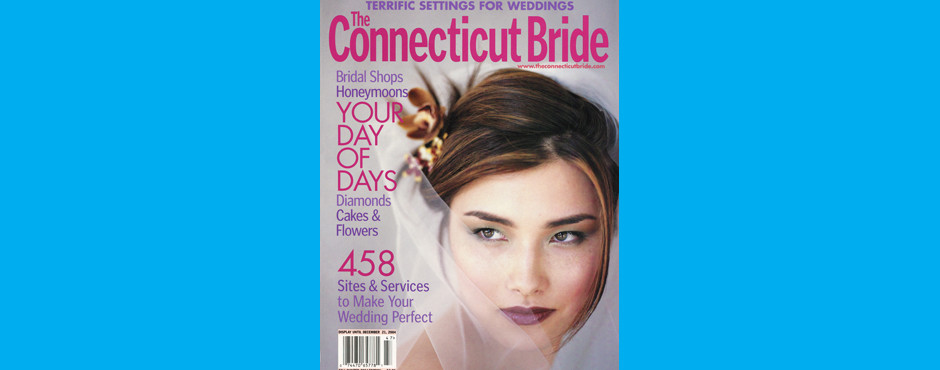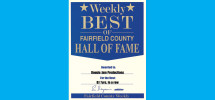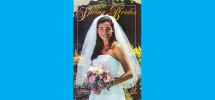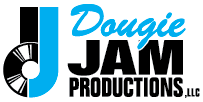Music:
Happy Feet
Music savvy brides and grooms keep wedding musicians hopping
“If music be the food of love, play on,” wrote Shakespeare, and indeed, it’s hard to imagine the greatest of all lovefests–a wedding day–without an equally wonderful soundtrack. Connecticut’s brides and grooms, like couples everywhere, have their own favorite songs, revered customs and preferences as to how their special day should sound. We talked to some local wedding musicians and disc jockeys about current trends.
THE CLASSICS STILL COUNT. Despite what you may have heard about the “ loosening” of musical traditions in wedding ceremonies, most musicians assert that couples’ Top Three requested processional/recessional playlist these days consists of Johann Pachelbel’s Canon in D, the wedding music from Richard Wagner’s opera Lohengrin (“Here Comes the Bride”) and Flix Mendelssohn’s Wedding March from A Midsummer Night’s Dream. “I’d say that’s true 95 percent of the time,” says Ross Tucker of Wethersfield’s New Orleans-style jazz/swing ensemble, The Hot Cat Jazz Band.
Song selections requested for a service, Bridgeport-based ceremonial singer Natalie Cappiello says, also tend to be “the old saws. Songs like “How Great Thow Art” and “Amazing Grace” are perennially popular because they’re timeless.” And she notes that the Catholic Church still “prefers that any songs in a ceremony be sacred and pertinent to the lithurgy that has taken place–they sometimes forbid secular songs outright. So the “Ave Marias,” whether by Schubert or Bach, are still hugely popular.”
Of course, not every house of worship is Catholic, and more and more wedding ceremonies now take place at reception sites, where anything goes. Doug Wheeler, president of Trumbull’s disc jockey service Dougie Jam Productions, remembers a couple who wanted The Monkees’ “I’m a Beleiver” played after they said their vows. “The bride had Pro Ked ho-tops on under her dress, the groom wore sneakers, too, and they literally skipped down the aisle,” he recalls. Other nonclassical requests for ceremonies have included Beatles songs, country & western tunes, James Brown’s “I Feel Good,” John Lennon’s “Grow Old with Me,” Dan Fogelberg’s “Since You’ve Asked” and Natalie Cole’s “This Will Be”.
In some cases, music choices become explicitly personal. “Since 9-11, I think a lot of people have asked themselves, “What creates true meaning in my life? How can I share it with my friends?’” says Jim Nuzzo, president of Dance to the Music Entertainment in Norwalk. “Some couples even ask for special music to be written for their ceremony. And multiculturalism has had a big impact on musical inclusion. So, depending on their backgrounds, some couples will ask for, say, a Portuguese love song to be played at their ceremony, immediately followed by an Italian love song.”
BYWORDS FOR WEDDING BANDS: VERSITALITY, FLEXIBILITY, CUSTOMIZATION. Working as a wedding musician used to make you grist for a lot of bad jokes; now it’s a serious, and competitive, business with proud practictioners. Gary Ribchinsky, leader of Ivoryton’s seven-piece Long Island Sound Band, studied classical and jazz at the Boston Conservatory. The LISB, founded in 1974, has played for Presidents Carter, Reagan, and Clinton. “Wedding music is now considered a highly specialized skill, and breaking into a wedding band is desirable because it compensates well, but it’s not that easy,” he says. “You have to have many qualifications to get into my group.”
Chief among these is a chameleonic nature. So if a couple want live music from ceremony through reception, they don’t have to audition (or pay) different bands for each phase. The LISB breaks down into a jazz trio (upright bass, saxophone and piano) for cocktail- hour music, and Ribchinsky subcontracts his wife’s classical trio –an ensemble of flute, violin and cello known as Trio Amabile–for ceremonies. Wethersfield’s Hot Cat Jazz Band offers a trio that can play both classical ceremonies and jazz cocktail hours. The Joe Holmes Swing Band, of Norwalk, usually specializes in the music of Cole Porter, George Gershwin and Benny Goodman; its classical configurations include a guitar and flute duo or trio of flute, violin and cello. Westport’s Cracked Ice Band is a horn-based rock ‘n’ roll group, but leader Crispin Cioe can provide a classical trio of guitar, piano and flute or subcontract a friend’s string quartet for a couple’s ceremonial needs.
While hiring wedding bands is becoming a kind of one-stop shopping at its most convenient, designing a playlist for the wedding reception is an ever more intricate process. These days, brides and grooms strive to entertain/appease as many guests as possible, so they may want a program that includes ‘60s Motown, ‘70s classic rock and ‘40s swing (with at least a handful of pop chestnuts on the side and a little Disney for the munchkins). A smart band–even one with a well-defined niche–can play them all. Or at least, knows how to meet the consumer halfway.
“Every job we do is a little different,” says Ross Tucker of the Hot Cat Jazz Band. “We just got a call from a bride-to-be in New York; she wants mostly swing and big band music. Some clients will mix that with Latin music–cha-chas and tangos–others want contemporary pop. Some people want dancing as the focus after dinner, others don’t.”
Virtually every band offers its potential clients a song list of its standard wedding repertoire, which the bride and groom are then invited to modify. “We’ve always been willing to add material, so our song list has grown much more extensive over the years,” Ribchinsky says. “But you can’t get carried away. If a couple wants too much of what a band doesn’t naturally do, they’ve hired the wrong band.”
As in ceremonies, the rise in interracial and intercultural marriages has influenced changes in reception playlist. Ethnically “themed” selections are in greater demand than ever. “I play in a klezmer band called The Klezzical Tradition,” says Ribchinsky, “so Jewish weddings are a favorite. I’m also conversant with Irish, Italian and Greek music. I remember one wedding for which the couple had invited 30 guests from Ireland, and I developed a repertoire of some authentic Irish music for them, mixed in with ‘I Will Survive’ and ‘Brown-Eyed Girl.’ It was a tremendous success.”
HAVING YOUR MUSICAL CAKE AND EATING IT,TO. Despite the current adaptability and class of live bands, there’s no question that disc jockeys are the most popular purveyors of wedding music. While the average band’s annual wedding bookings top out at about 35 or 40, DJ services (depending on how large they are) fill 100 to 800 dates a year. The key explanation for this discrepancy: You can obtain a suitable DJ for around $1000, but a good band will run you $3,000 to $10,000.
Beyond value-for-the-money issues, there are many good reasons couples hire a DJ. Chief among these is that playlists are 100 percent customizable, and every song a couple loves can be played in precisely the form they first loved it. Plus, the DJ can throw in a whole assortment of entertainment extras to keep the guests warmed up, including lighting effects, contests, professional dancers and audience participation. The latest big thing nationwide, notes Doug Wheeler of Dougie Jam Productions, is the Video Dance Party. “Our service has a collection of more than 3,600 live music videos, featuring everyone from Chubby Checker to Justin Timberlake, that we broadcast on a 6-by-5-foot screen,” he says. “It gives a little more of the feel of having a live wedding band perform.
“Nonetheless, I think the trend for the last year or two is that brides are looking for a more elegant, sophisticated approach from us. We went through a period in the 1990s when everyone wanted an interactive DJ who led the line dances, dressed in costume, handed out props. Now, they want us to stay behind the ropes a little.” Jon March, of Cheshire DJ service Powerstation, agrees. “Our angle is ‘Fun with Class,’” he says. “No chicken suits, no hula hoops.”
A growing number of couples are opting for both band and disc jockey–and service providers are gladly making the combination work. “Roughly 15 years ago, if a couple asked me to play a record for their first dance, I’d refuse,” says Gary Ribchinsky. “Now I’ve turned the corner and realized I can be more successful by offering both band and DJ services during an event. It allows the Long Island Sound Band to offer continuous music, and that’s the new keyword in the market: Everyone wants continuous music.”
Some bands bring their own disc jockeys to a wedding; others are content to slip a burned CD-R into their sound system while on break, satisfying the guest’s desire to dance to songs that the band itself might not be able to play. And certain DJ services will gladly contract a split DJ/band bill for a wedding, with sets of live and canned music trading off throughout the event. “I enjoy collaborating with disc jockeys,” says the Cracked Ice Band’s Crispin Cioe. “They bring a big system sound into the reception hall that younger guests really love.”
SOME DANCE SONGS ARE HOT; SOME NOT. When it comes to what they find “danceable,” Connecticutians seem to be a little more conservative than their neighbors in the “big city.” Says Doug Wheeler: “New Yorkers will dance to the newest song on the radio as long as it’s got a beat. Here, people won’t dance to anything new unless it’s already been played to the hilt, like OutKast’s ‘Hey, Ya!’”
According to reports, Manhattan’s latest big trends in wedding dance music are actually rather retro themselves–‘80s rock and sophisticated ‘30s and ‘40s jazz–and they’re just beginning to infiltrate certain Fairfield County receptions. Couples hosting those affairs have long deep-sixed the obligatory run-through of “New York, New York” and line dances like the Electric Slide and Macarena, which are just barely hanging onto the playlist elsewhere. As far as certain entertainers are concerned, those traditions can’t fade out too soon. “We won’t go anywhere near the Chicken Pokey,” says Karin Barth, leader of Mystic-based swing/R&B band The Cartells.
Other songs show amazing persistence and no one seems to mind, particularly those strongly associated with the “first dance” (“At Last”) and the father-daughter dance (“Daddy’s Little Girl”). No one song dominated the mother-son dance until the early 1990s, when an artist named Mikki Viereck produced a tune called “A Song for My Son on His Wedding Day,” which says Wheeler, “has been the standard ever since.”
POPULAR WEDDING SONGS ARE MORE OFTEN “SEEN” THAN HEARD. Once upon a time, you feel in love with (or to) a great song because you caught it on the radio. These days, with FM “narrowcasting” the way it does, that’s far less likely, unless the song is a Top 10 smash. Chances are, if it’s a classic of any stripe or something “alternative,” you encountered it on a movie soundtrack, a TV talk show, perhaps even a GAP or Budweiser commercial. “Visual media have replaced radio as a primary education source for music,” says Jon March of Cheshire’s Powerstation. “That’s how younger generations learn about the Beatles and Frank Sinatra. Or even current artists like Diana Krall.”
When Harry Connick Jr. crooned “It Had to Be You” and “Autumn in New York,” Frankie-style, in the 1989 film When Harry Met Sally, he reinvigorated a love for pop standards that still defines many wedding reception music programs (especially since the torch continues to be carried by both new artist Michael Bublé and old timer Tony Bennett, who serenaded Billy Crystal and Lisa Kudrow with “All the Way” in 1999’s Analyze This). The Mask, from 1994, and 1996’s Big Night likewise sparked a hardy revival of interest in swing music and its master, Louis Prima, that climaxed with Brian Setzer’s rockified cover “Jump, Jive An’ Wail” in 1998.
What’s the latest wedding trendsetter in the visual media? Please don’t groan: “I think ‘American Idol’ is having a big effect now, because they expose the audience to so much classic Motown,” says Crispin Cioe.
PARTY TILL YOU DROP, THEN PARTY ON. “In the last few years,” says Joe Holmes of Norwalk’s Joe Holmes Swing Band, “a handful of weddings we’ve played have gone like this: The reception ends after the obligatory four or five hours, people leave, the band packs up . . . but it’s all a ruse. Because another party is about to begin that’s by invitation only. We just did one at the New Canaan Country Club. The wedding party all went into the locker room and changed into their casual clothes; a half-hour later, Phase Two started. We did one last year where we even had to drive to a second location for another four-hour event.”
Crispin Cioe notes that over the last year, his Cracked Ice Band has logged a lot of overtime, too. “I’ve played more and more weddings at which the receptions went on three or four hours longer than expected,” he says. “I think it’s because there are more music lovers planning weddings these days. We’re doing a wedding in the fall for a couple who loves New Orleans music; they gave us a specific list of 42 songs they want us to play. When I started playing weddings 10 years ago, this kind of musical knowledge and enthusiasm didn’t exist.”
For more info www.theconnecticutbridemagazine.com.





